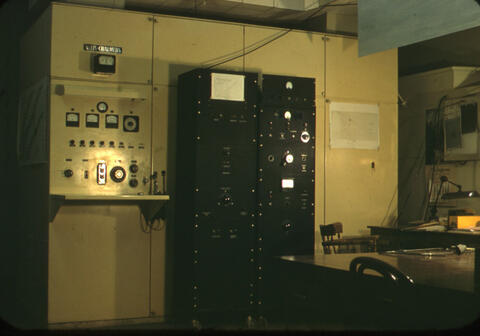
Title and statement of responsibility area
Title proper
Betatron
General material designation
- Graphic material
Parallel title
Other title information
Title statements of responsibility
Title notes
Level of description
Item
Reference code
Edition area
Edition statement
Edition statement of responsibility
Class of material specific details area
Statement of scale (cartographic)
Statement of projection (cartographic)
Statement of coordinates (cartographic)
Statement of scale (architectural)
Issuing jurisdiction and denomination (philatelic)
Dates of creation area
Date(s)
-
[1948?] (Creation)
Physical description area
Physical description
1 slide : col. ; 6 x 6 cm
Publisher's series area
Title proper of publisher's series
Parallel titles of publisher's series
Other title information of publisher's series
Statement of responsibility relating to publisher's series
Numbering within publisher's series
Note on publisher's series
Archival description area
Name of creator
Custodial history
Scope and content
Image of the betatron control panels.
Bio/Historical Note: In May 1948 Dr. Harold E. Johns, Dr. Newton Haslam, and Dr. Leon Katz, professors of Physics at the University of Saskatchewan, travelled to Milwaukee to inspect the betatron that had been built for the U of S. In August of that same year, the U of S installed in the Physics Annex the first betatron in Canada—the world’s first betatron used for a cancer treatment program. Dr. Johns then began the design and construction of one of the first cobalt-60 teletherapy units. Dr. Johns and his graduate students became the first researchers in the world to successfully treat a cancer patient using cobalt-60 radiation therapy. It was also used for research programs in nuclear physics, radiation chemistry, cancer therapy and radiation biology. In 1951 the world’s first calibrated Cobalt-60 cancer therapy unit was installed at University Hospital (G Wing). The calibration work was done by Dr. Sylvia Fedoruk through rigorous depth dose measurements. In early 1952, Maclean's magazine had dubbed the cobalt-source radiotherapy machine the cobalt bomb - a tongue-in-cheek tribute to this peaceful use of nuclear technology. Dr. Johns’ pioneering work in cobalt-60 teletherapy became the gold standard for radiation therapy for many years and thousands of units were installed worldwide, helping countless patients. The original treatment device was used in Saskatchewan until 1972. The work Dr. Johns and his team did on the physics of high energy photon beams was fundamental, and still forms the basis of most treatment planning systems in use today.
Notes area
Physical condition
Immediate source of acquisition
Arrangement
Language of material
Script of material
Location of originals
Availability of other formats
Restrictions on access
Terms governing use, reproduction, and publication
Photographer: Gibson
Other terms: Copyright: University of Saskatchewan

